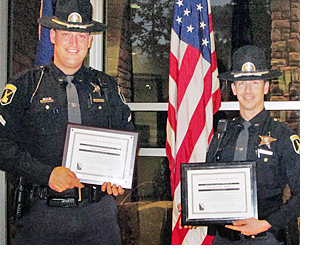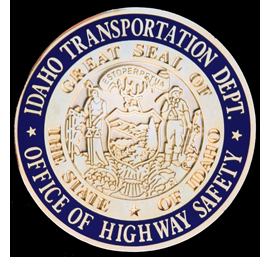
ISP officers earn Highway Safety Office awards for crash data work
 Idaho’s official crash statistics are only as good as the data behind them.
Idaho’s official crash statistics are only as good as the data behind them.
For ITD’s Office of Highway Safety, that means law enforcement officers fill out an accurate Idaho Vehicle Crash Report (IVCR) for every crash that involves a motor vehicle, occurs on public property and results in more than $1,500 in property damage for any one person involved, or results in an injury to any person involved.
Kirstin Weldin works with the Idaho Mobile Program for Accident CollecTion (eIMPACT) and serves as a liaison for the eIMPACT program. She also is the law enforcement instructor, traveling regularly throughout the state training officers in how to use the software program.
She thanked two Region 1 Idaho State Police officers in November with OHS challenge coins for their outstanding work regarding eIMPACT reporting and their willingness to assist.
Cpl. Allen Ashby and Cpl. Glenn Bakken received the symbolic coins and certificates of appreciation last month for developing an improved report approval process that Weldin said she intends to expand.
“I feel that they have helped me to not only become a better instructor by allowing me to view the program from a law enforcement perspective, but they have really inspired the direction that I am taking the eIMPACT training programs,” she said. “Because of them, I have been able to develop a new training class on the approval process that will lead to greater consistency in our data.”
 Idaho is one of only a few of states that have made its crash reporting 100 percent paperless and is becoming well known nationwide for the quality of its data.
Idaho is one of only a few of states that have made its crash reporting 100 percent paperless and is becoming well known nationwide for the quality of its data.
The eIMPACT software allows law enforcement agencies to store crash information locally, and transmit the data to OHS electronically. That allows easy data access for the agencies and eliminates their need to maintain paper copies or mail paper copies to ITD. It also eliminates the need to re-enter data into the OHS database.
Weldin encourages law enforcement agencies to use the information ITD gathers to improve their own local safety and enforcement efforts.
“It’s not just about ITD using the information,” she explained. “The information gathered can help our law enforcement partners and their local agencies understand exactly where crashes are taking place and why crashes are happening, leading to more effective patrol efforts.”
Information collected from the reports influences everything from legislative decisions, traffic enforcement, grant funding allocations and program development, to educational and outreach efforts.
“Our business is very data driven,” she said. “Access to current and accurate data serves an essential role in developing our goals, evaluating outcomes and establishing progress in aspects of highway safety as we continue to eliminate deaths and serious injuries on Idaho’s roadways with the vision of Toward Zero Deaths.”
Published 12-6-13